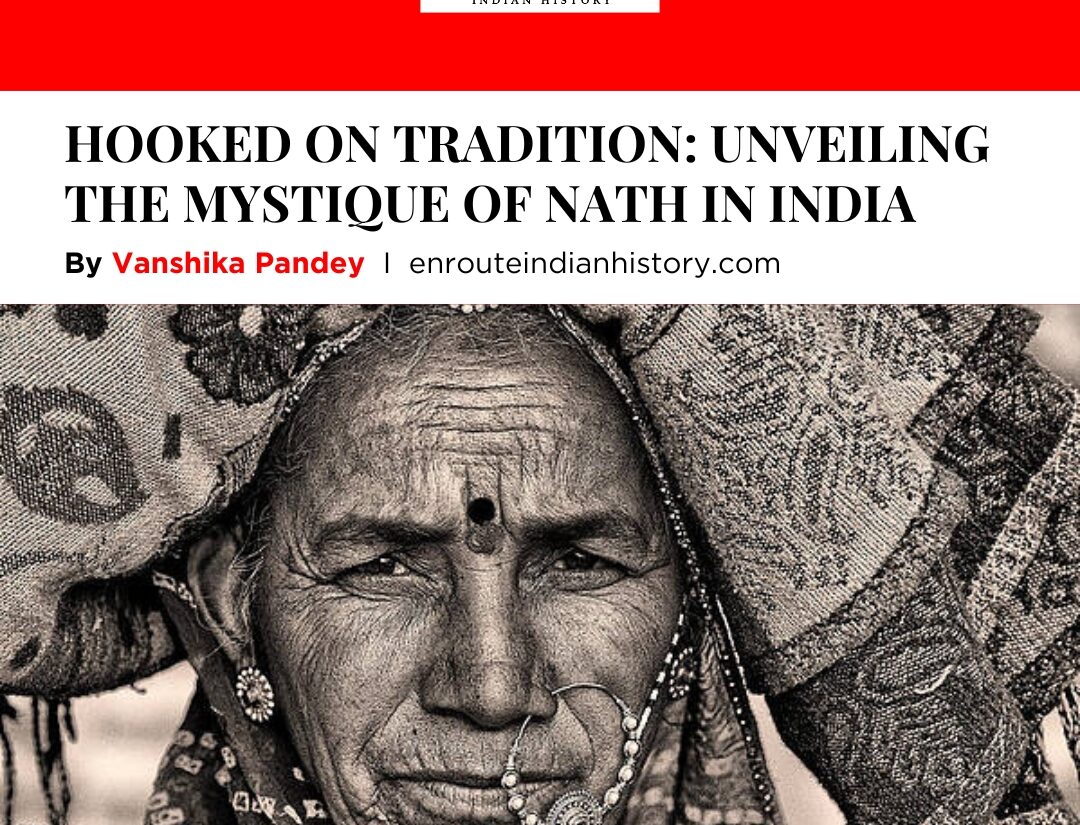Hooked on Tradition: Unveiling the Mystique of Nath in India
- EIH User
- August 1, 2024

Nosepins, or naths, hold a significant place in Indian culture, particularly among women. This traditional piece of jewelry is not just a fashion accessory but also carries deep cultural and religious meanings. In Indian weddings, the bride is often adorned with a nosepin as a symbol of her marital status and cultural identity. The intricate designs and materials used in nosepins also reflect the wearers social status and personal style. Despite changing fashion trends, the nosepin continues to be a timeless symbol of tradition and femininity in Indian society. Understanding the importance of nosepins in Indian culture and womens perspectives provides valuable insights into the diverse and rich cultural heritage of India.

Caption- A Gujarati woman wearing Nath
Source- Fineartamerica.com
Nosepin
The nosepin, or nath, is a significant cultural ornament in Indian society, symbolizing marital status, beauty, and femininity. It is an essential part of a bride’s attire, believed to bring good luck and prosperity. The design varies across Indian states, from simple studs to elaborate chains, reflecting the country’s diverse traditions. The nath is also worn during religious rituals and festivals, symbolizing respect, devotion, and commitment to cultural values. Additionally, it is believed to have medicinal benefits in Ayurvedic practices. This blend of cultural, religious, and medicinal aspects highlights the nath’s importance in Indian culture.
In Indian culture, they are deeply connected to femininity and identity, symbolizing marriage, social status, and beauty. They indicate marital status with different designs for married and unmarried women and are often cherished heirlooms passed through generations. Women use nosepins as a form of self-expression, choosing designs that reflect their personality or cultural heritage. Despite changing fashion trends, the tradition of wearing nosepins endures, preserving their cultural importance. Beyond their symbolic value, nosepins are also believed to have therapeutic benefits in Ayurvedic medicine, such as enhancing respiratory health or alleviating headaches. This dual significance—cultural and practical—highlights the multifaceted role of nosepins in Indian society.
Nosepins are significant not just as accessories but as symbols of empowerment and pride in heritage. For many women, wearing a nosepin is a way to assert their identity and cultural roots in a rapidly changing society. This choice can express cultural pride and autonomy over one’s body and appearance, making nosepins symbols of cultural resistance and resilience. Historically, nosepins have indicated marital status and social standing, evolving into fashion statements and expressions of personal style. They are often featured in Indian art forms, like dance, music, and cinema, where they are part of traditional attire. Additionally, nosepins are believed to offer health benefits in Ayurveda, such as regulating breathing and enhancing well-being. Overall, nosepins symbolize tradition, beauty, and elegance in Indian culture.
In addition to being a significant jewelry piece in Indian culture, nosepins also have deep-rooted historical origins. The tradition of wearing nosepins, also known as naths, can be traced back to ancient texts, sculptures, and paintings dating back to the Indus Valley Civilization, around 2500-1500 BCE. In these artifacts, women are depicted adorning elaborate nosepins, indicating that the practice has been a part of Indian tradition for thousands of years. The significance of nosepins in Indian culture is also evident in various mythological stories and religious texts, where women are often described wearing nose ornaments as a symbol of beauty and marital status. Over the centuries, nosepins have evolved in design and style, reflecting changing fashion trends while still retaining their cultural and symbolic importance in Indian society . The rich history of nosepins in Indian culture showcases the enduring tradition and cultural significance of this jewelry piece.
Nosepins also exhibit a remarkable diversity across the country’s regions, each style reflecting unique cultural, historical, and aesthetic values. In northern India, particularly in states like Rajasthan and Uttar Pradesh, the nosepin, or “nath,” is often large and elaborate. These naths, adorned with pearls, beads, and gemstones, are traditionally worn by married women and hold symbolic significance in ceremonies like weddings. The “ballu nath” of Jammu, a distinctive variant, features a large hoop with intricate detailing, often signifying cultural pride and regional identity.
In the south, particularly in Tamil Nadu and Karnataka, simpler, smaller studs called “mookuthi” are popular. These studs often feature delicate, intricate designs that showcase the region’s rich artistic heritage, sometimes incorporating motifs like flowers or peacocks. In Maharashtra, the “brahmani nath” is a traditional ornament associated with Brahmin women, characterized by its crescent shape and use of pearls, symbolizing both beauty and social status.
In the northeastern state of Assam, the “mukhuti” is a small, often gold or silver nosepin, sometimes adorned with a single gemstone. This modest yet elegant design reflects the region’s cultural ethos of simplicity and grace. In Gujarat, the “chhabi” or “karnphool nath” is another distinctive style, often worn during festivals and significant life events.
Beyond mere ornamentation, nosepins in India often hold deeper spiritual and cultural significance. In some traditions, the piercing of the left nostril is believed to be connected to reproductive health, easing childbirth and menstrual pain. This practice is rooted in Ayurvedic beliefs that link the left nostril with the female reproductive organs. The variation in nosepins across India not only underscores the rich tapestry of regional traditions but also highlights how jewellery serves as a conduit for cultural expression, personal identity, and social status across different communities.
Apart from the regional diversity, one particularly interesting symbolism of Nath was seen among the courtesans of the Mughal era, or Tawaifs, for them the nath was more than just an ornament; it was a powerful symbol of status, artistry, and agency. Traditionally, in many parts of India, the nath is worn by married women as a symbol of their marital status. However, for the tawaifs, who were often independent and not bound by the conventions of marriage, wearing the nath could be seen as an assertion of their autonomy. It represented a unique blend of adherence to cultural norms and a subtle subversion of them. The tawaifs occupied a complex social position; while they were respected for their cultural contributions, they also lived on the margins of conventional society. The nath, in this light, became a symbol of their unique status—both within and outside societal norms. A ceremony which particularly catches attention when talking about Nath and Tawaif is the ceremony of ‘Nath Utarayi’ or Nath removal ceremony. In some communities, Nath Utarai is done as a symbol of mourning after a woman’s husband passes away. In some other north Indian setups, a new bride does Nath Utarai for a period lasting between 1 month to 1 year marking the completion of a specific phase in her life and transition to a new phase, However, for a courtesan, this means a whole different thing, this ceremony symbolizes the transition in the life of that woman, the girl would be dressed like a bride and would wear a big nose ring on the left side of her nose. This nose ring was a symbol of her virginity. Whoever made the highest bid would have the first night with that girl. After this night the girl would never wear a nose ring, and the man who bid on her would ‘own’ that courtesan forever.
In conclusion, the nosepin (nath) holds significant cultural and symbolic importance in Indian society, particularly for women. Its role extends beyond just being a piece of jewelry; it represents tradition, marital status, and social standing. Through interviews and surveys with Indian women, it became evident that the nosepin is viewed as a powerful symbol of identity and heritage, with many expressing a deep emotional connection to wearing it. The research highlighted the intricate blend of cultural, social, and personal meanings attached to the nosepin, showcasing its enduring relevance in contemporary Indian culture. As such, the nosepin serves as a tangible link to the past, reinforcing a sense of connectivity and belonging for Indian women across generations.
References
- Doranne Jacobson, “Women in India”, 1986
- P. K. Gode, “ The Antiquity of the Hindoo Nose-Ornamant Called Nath, 1939


















